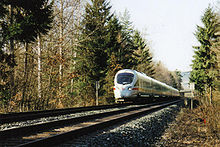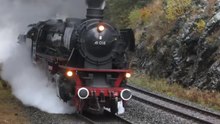Inclined plane (railway line)
| Inclined plane | |||||||||||||||||||||||||||||||||||||||||
|---|---|---|---|---|---|---|---|---|---|---|---|---|---|---|---|---|---|---|---|---|---|---|---|---|---|---|---|---|---|---|---|---|---|---|---|---|---|---|---|---|---|
|
41 018 on the Inclined Plane (2016)
| |||||||||||||||||||||||||||||||||||||||||
| Route number : | 5100 | ||||||||||||||||||||||||||||||||||||||||
| Course book section (DB) : | 512, 820, 850 | ||||||||||||||||||||||||||||||||||||||||
| Gauge : | 1435 mm ( standard gauge ) | ||||||||||||||||||||||||||||||||||||||||
| Maximum slope : | 25 ‰ | ||||||||||||||||||||||||||||||||||||||||
| Top speed: | 120 km / h | ||||||||||||||||||||||||||||||||||||||||
|
|||||||||||||||||||||||||||||||||||||||||
The inclined plane is a section of the Ludwig-Süd-Nord-Bahn from Bamberg to Hof (Saale) , a steep section with a maximum incline of 1:40.
Geographical location
The inclined plane is located in the district of Kulmbach , in the administrative district of Upper Franconia in Bavaria . It begins east of the Neuenmarkt-Wirsberg train station and ends in the Marktschorgast train station .
description

On the way from the Main Valley to the Rhine-Elbe-Watershed on the Münchberg plateau, the ramp overcomes 6.8 kilometers of 157.7 meters in altitude with a gradient of up to 25 ‰. Like the entire Ludwig-Süd-Nord-Bahn, the inclined plane was built with a substructure for a double-track line, but initially only one track was laid. It wasn't until 1871 that the funds for the second track between Untersteinach and Oberkotzau were approved. Because of the numerous retaining walls, incisions and stone dams, it is considered a technical masterpiece of its time. Today it is a cultural monument due to the Bavarian Monument Protection Act .
Today, the line has been expanded to consist of two tracks and is not electrified . On the section between Marktschorgast and Stammbach that adjoins the steeply sloping line , the second track has now been expanded. To the east of Neuenmarkt-Wirsberg station, the so-called Schlömener curve was opened for fast tilting technology traffic in 2001 , with which this station can be bypassed on the way from Bayreuth to Hof .
In the meantime, the tracks in Marktschorgast station have been almost completely dismantled. Only the two continuous main tracks and a one-sided track change in the western entrance have been preserved.
history

The route variants initially planned from 1836 provided for a steep stretch with a steeper incline and the use of stationary steam engines and / or horse-drawn trams . This was given up in favor of a continuous locomotive covering and a more stretched, flatter route when more powerful locomotives were available. The example of the route of the Baltimore and Ohio Railroad from Baltimore to Wheeling was followed. Locomotives with bogies were used there, which could also take tighter curves. However, the latter was not used in Bavaria. Tender locomotives with a fixed wheelbase were procured here , which traveled over the inclined plane to Hof, from where Saxon locomotives continued to move the trains. The Bavarian locomotives belonged to classes B (four driving wheels , two running wheels ) and C (six driving wheels). Class B was used in front of passenger trains, class C in front of freight trains and in the pushing and tensioning service. The latter was specially developed for the inclined plane in 1847.
The steep stretch was a very early construction project in terms of railway history. It was built between 1844 and 1848 and opened on November 1, 1848. Their maximum gradient of 25 ‰ was also the maximum that steam locomotives built at the time could achieve in normal operation. The construction was carried out by the "Eisenbahnbau-Section Münchberg ". The construction costs amounted to 917,318 guilders .
Around 1892, an intermediate block was set up about halfway up the ramp at km 77.9 . It was equipped with a signal for the mountain and valley tracks. When a train going uphill passed the block, the guard set the signal back to "Stop". A train waiting in Neuenmarkt could already depart. Since at that time a freight train took more than half an hour to negotiate the ramp, a significant increase in the line permeability could be achieved.
Two kilometers below Marktschorgast, on both sides of the route at km 79.7, there are two pillars, each consisting of nine concrete segments, a "falling body barrier" that was built in 1983, during the Cold War . In an emergency, explosives in a cavity below would have exploded, and the concrete segments would have fallen onto the tracks. With this it was hoped to be able to stop advancing Warsaw Pact troops . The facility is now a listed building .
business
Sliding operation and double covering
The route was an operational challenge in the times of steam locomotives. Many trains had to be reinforced with sliding locomotives or a second, pre-tensioned locomotive. They were stationed in the Neuenmarkt-Wirsberg depot in Neuenmarkt . These included class 95 locomotives , but also class 57 and 50 locomotives . From 1935 to September 1, 1944, Mallet locomotives of the 96 series performed pushing services on the Inclined Plane . In the early 1970s, the line was one of the last locations in which the 01 series operated by the Deutsche Bundesbahn .
Railway accident in 1944
On December 27, 1944, a serious railway accident occurred when a military train derailed at Neuenmarkt station after the train's brakes could not reduce its speed sufficiently on the Inclined Plane. The exact cause is unknown. The train was hauled by locomotive 58 2813. In the accident the stoker, the train driver and a NCO were killed. There were also several seriously and slightly injured people.
ICE TD traffic and subsequent operation

From 2001 to 2003 the inclined plane was used by ICE-TD railcars ( DB class 605 ) with tilting technology. Due to technical problems, the trains were shut down by order of the Federal Railway Authority . Until 2004, repainted tilting railcars of the DB class 612 were used as an intercity . Class 612 trains are still in use today, serving the regional express lines Hof– Würzburg and Hof– Lichtenfels as well as the regional express line Nürnberg – Hof. The latter drove to Dresden until December 2014. Since then, push- pull trains hauled by electric locomotives without tilting technology have been used for this section .
Museum facilities
The German Steam Locomotive Museum is located at the foot of the ramp in the former depot of the Neuenmarkt-Wirsberg station . In addition to its permanent exhibition, it organizes special trips with steam locomotives over the inclined plane at irregular intervals, mostly in cooperation with other museums and locomotive operators.
In the mountain station, in the former waiting room of the Marktschorgast train station, there is a small museum and an information center on the history of the Inclined Plane.
The Marktschorgast train station is the starting point of a railway history hiking trail that runs along the inclined plane and tells the story of the route on display boards. The approximately 8 km long hike ends at the entrance to the steam locomotive museum.
literature
in alphabetical order by authors / editors
- Gernot Dietel: The inclined plane at Neuenmarkt. Application of a new railway system to overcome mountains . In: Yearbook for Railway History 48 (2017/2018), pp. 25–44
- Gernot Dietel, Roland Fraas: Railway in Münchberg 1848–1998 . Münchberg-Helmbrechtser Zeitung, Münchberg 1998. ISBN 978-3-938463-01-7
- Andreas Knipping: Giant for Franconia's ramps . In: LokMagazin 1/2017.
- Steffen Lüdecke: The Inclined Plane. A legendary railway line . EK-Verlag, Freiburg im Breisgau 1993, ISBN 3-88255-833-4 .
Web links
- Inclined plane - fascination with a historical monument of the German Steam Locomotive Museum Neuenmarkt-Wirsberg
- The inclined plane between Neuenmarkt = Wirsberg and Marktschorgast ... of the working group Initiative inclined plane
- Railway history of Bayreuth and the surrounding area with a focus on the inclined plane of the Bayreuth eV history workshop
- Route description at the train comes
Remarks
- ↑ The model for this was the corresponding routes in Great Britain : They had maximum gradients of 5 ‰ and curve radii not less than 3000 feet (approx. 870 m) and the gradients were overcome by stationary steam engines that carried the wagons upwards by cable. In Germany, a corresponding plant was z. B. built with the steep ramp Erkrath-Hochdahl .
Individual evidence
- ↑ Inclined plane at dampflokmuseum.de, accessed on September 2, 2014.
- ^ Gernot Dietel, Roland Fraas: Eisenbahn in Münchberg 1848–1998 , p. 162.
- ↑ Monument No. D-4-77-139-26
- ↑ Dietel / Fraas: Eisenbahn in Münchberg , p. 32 ff.
- ↑ Dietel / Fraas: Eisenbahn in Münchberg , p. 191 ff.
- ↑ Knipping, p. 47.
- ↑ Dietel: The Inclined Plane , p. 40f.
- ↑ Steffen Lüdecke: The Inclined Plane. The legendary steep ramp in Upper Franconia . 4th edition. EK-Verlag, Freiburg im Breisgau 2016, ISBN 978-3-88255-594-3 , p. 294 ff .
- ↑ Steffen Lüdecke: The Inclined Plane. A legendary railway line . EK-Verlag, Freiburg im Breisgau 1993, ISBN 3-88255-833-4 , p. 292 .
- ↑ Master of locks and bridges . In: Nordbayerischer Kurier of October 30, 2014, p. 21.
- ↑ Knipping, p. 53.
- ^ Jürgen Goller, Wolfram Alteneder: Railway junction Neuenmarkt-Wirsberg. Inclined plane, connecting railways, railway depot . German Steam Locomotive Museum, Neumarkt 1982.
- ↑ a b Network - Saxony-Franconia Magistrale. Chronology. Saxon-Bavarian city network, accessed on May 22, 2015 .
Coordinates: 50 ° 4 ′ 31.2 ″ N , 11 ° 36 ′ 52.6 ″ E





